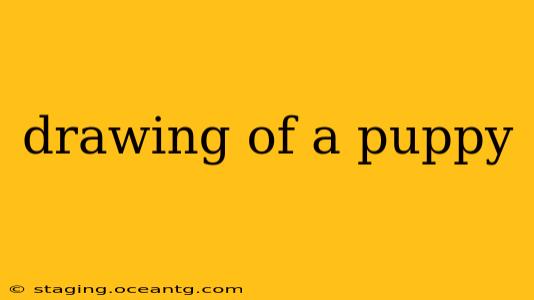Drawing a puppy can be a fun and rewarding experience, regardless of your skill level. This guide will walk you through the process, from basic shapes to adding those adorable puppy features. Whether you're a complete beginner or looking to refine your skills, we'll cover techniques to help you create a charming canine masterpiece.
What Supplies Do I Need to Draw a Puppy?
Before we begin, let's gather your materials. You don't need expensive art supplies to create a lovely puppy drawing. Here's what you'll need:
- Paper: Any drawing paper will do, but thicker paper is preferable to prevent smudging.
- Pencils: A range of pencils (e.g., HB, 2B, 4B) allows for varying line weights and shading. A hard pencil (like an HB) is good for sketching, while softer pencils (like 2B and 4B) are great for shading and darker lines.
- Eraser: A kneaded eraser is ideal as it can be molded to erase small areas precisely.
- Sharpener: Keep your pencils sharp for clean lines.
- Optional: Colored pencils, markers, or paints to add color to your finished drawing.
How to Draw a Puppy: A Step-by-Step Guide
Let's start with a simple, yet charming puppy drawing. We'll break it down into manageable steps:
Step 1: Basic Shapes
Begin by sketching the basic shapes that form the puppy's body. Think of a circle for the head, an oval for the body, and smaller circles or ovals for the legs. Don't worry about perfection at this stage; these are just guides.
Step 2: Refining the Shapes
Connect the shapes, gradually refining the outline of the puppy. Add a slightly curved line for the spine, connecting the head and body. Shape the legs, paying attention to the proportions. Remember, puppies have relatively larger heads compared to their bodies.
Step 3: Adding Details
Now it's time for the fun part! Add details such as the ears (floppy or pointed!), eyes, nose, and mouth. Think about the breed of puppy you're drawing – different breeds have unique features. Add a small tail.
Step 4: Shading and Texture
Use your softer pencils to add shading. This brings your puppy to life and creates depth. Pay attention to the light source and how it affects the shadows on the fur. Experiment with different shading techniques to achieve different textures – soft, fluffy fur might require lighter shading, while thicker fur might need darker shading.
Step 5: Adding Final Touches
Once you're happy with the shading, you can add final touches, such as whiskers, individual toes, and any other small details that bring personality to your puppy.
What are Some Tips for Drawing Realistic Puppy Features?
Eyes: Puppy eyes are large and expressive. Pay attention to the highlights in the eyes to create a sense of shine and life.
Nose: The nose is usually a dark, wet-looking area. Use darker shading to define it.
Fur: Consider the type of fur – long, short, curly, smooth. Adjust your shading techniques accordingly to depict the texture correctly.
What are Different Styles I Can Use to Draw a Puppy?
You can draw puppies in various styles:
- Realistic: Focus on accurate anatomy and details.
- Cartoonish: Exaggerate features for a fun and playful look.
- Abstract: Focus on shapes and forms, not necessarily realistic representation.
- Manga/Anime: Use the stylistic conventions of Japanese animation.
How Can I Improve My Puppy Drawing Skills?
Practice is key! The more you draw, the better you'll become. Try drawing different breeds of puppies, experimenting with different poses and expressions. Observe real puppies, studying their features and how their bodies move. Use reference photos to help you with proportions and details. Don't be afraid to experiment and have fun!
Drawing a puppy is a journey of creativity. Follow these steps, practice consistently, and watch your skills blossom. With patience and practice, you'll be creating adorable puppy drawings in no time!
